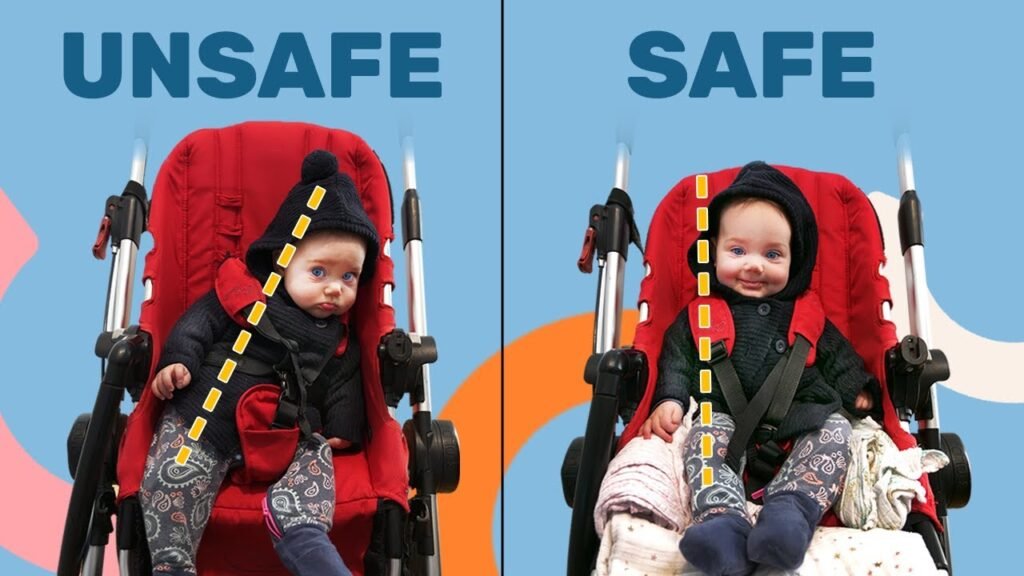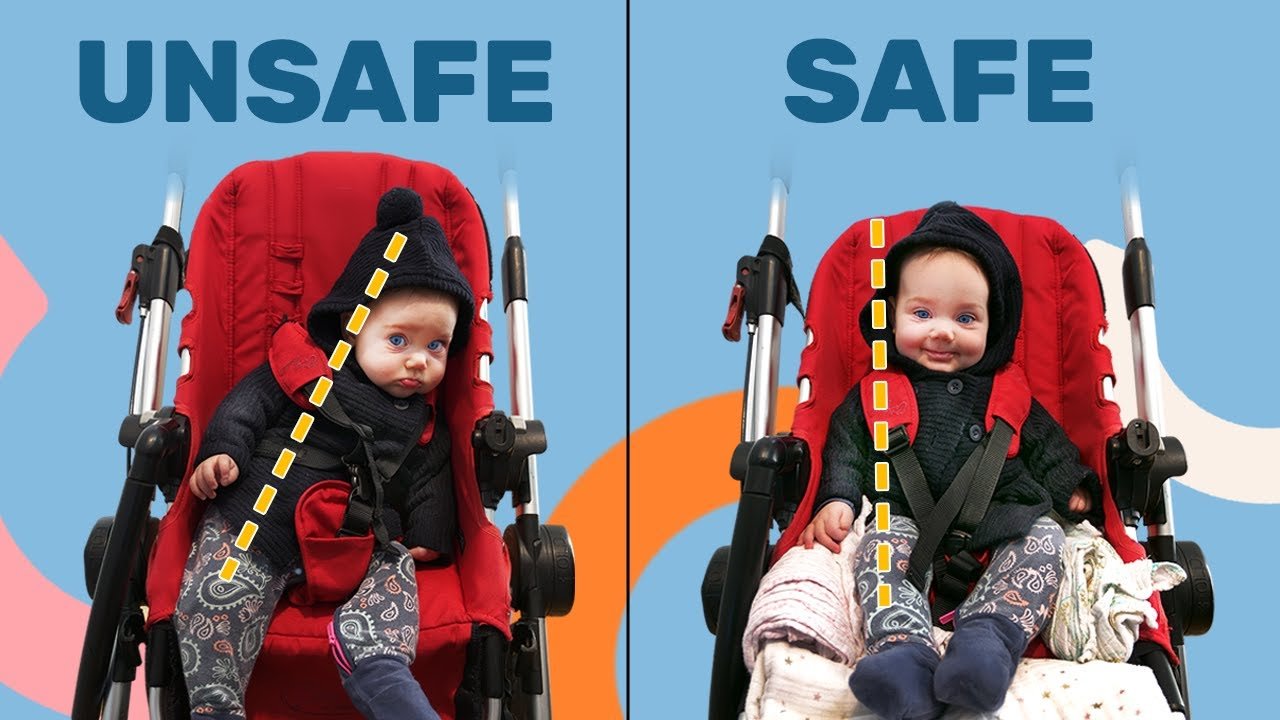Transitioning from lying flat in a pram to sitting up in a stroller can be a big milestone for your baby, usually occurring around 3 months of age. It’s important to ensure that the stroller is set up correctly to prioritize your baby’s safety and comfort. This means positioning the stroller seat at a semi-reclined angle to provide support for the head and neck, adjusting the harness to avoid chest restriction, raising the footrest for leg support, and placing rolled-up wraps or small blankets for extra comfort. As your baby grows and develops better head control, you can make adjustments to the stroller seat angle and remove the extra support. Remember to always seek professional medical advice for any health concerns or emergencies related to your baby.
Switching your baby from lying flat in a pram to sitting up in a stroller is a natural progression as they become more aware of their surroundings and spend longer periods awake. It’s crucial to set up the stroller correctly for their safety and comfort. This article provides tips on ensuring the stroller is properly adjusted, such as finding the right seat angle, positioning the harness correctly, raising the footrest, and using rolled-up wraps for added support. By following these guidelines, you can create a safe and comfortable environment for your baby as they enjoy their stroller rides. Remember, always consult with a medical professional for any health concerns or emergencies.
Setting up the stroller correctly
Choosing the right stroller
When it comes to choosing a stroller, there are a few factors to consider. First and foremost, make sure the stroller is suitable for your baby’s age and weight. Look for a stroller that has a seat that can be adjusted to a semi-reclined position, as this will provide the necessary support for your baby’s head, neck, and spine. Additionally, consider the size and weight of the stroller, as well as any additional features you may need, such as a sunshade or storage compartments. Take the time to research different stroller options and read reviews before making a decision.
Ensuring proper assembly
Before using your stroller, it is essential to assemble it correctly. Follow the manufacturer’s instructions carefully and make sure all parts are secure and in the correct position. Double-check that the wheels are attached securely and that the brakes are working correctly. If you have any doubts about the assembly, consult the instruction manual or contact the manufacturer for assistance. Proper assembly is crucial for the safety and stability of the stroller.
Adjusting the seat angle
To provide optimal support for your baby’s head, neck, and spine, it is essential to adjust the seat angle correctly. In a semi-reclined position, your baby’s head will be supported, and their chin won’t rest on their chest, making it easier for them to breathe. Start by setting the seat into a semi-reclined position and observe your baby’s comfort level. If they are trying to lift their head further to sit up, it may indicate that the seat angle is too far back. Gradually adjust the seat angle as your baby grows and develops better head control.
Positioning the harness correctly
The harness is an integral part of the stroller that ensures your baby’s safety. Position the shoulder straps at or just above your baby’s shoulders, making sure they are level and not too high. This will keep your baby secure without putting pressure on their neck or chest. The buckle on the crotch strap should be below your baby’s belly button and level with their hips to prevent them from slipping down and out of the stroller. Finally, ensure that the waist straps are level with your baby’s hips to provide additional support and stability.
Raising the footrest
At this stage, your baby’s legs may not be long enough to reach an angled footrest, so it is essential to raise it to their level. If their feet still do not rest on the footrest, you can place folded-up towels or blankets underneath their legs for extra support. This will help maintain proper posture and prevent their legs from dangling, which can cause discomfort and put pressure on their lower back and hips.
Providing proper support for the baby
Supporting the head, neck, and spine
Supporting your baby’s head, neck, and spine is crucial, especially during the transition from lying flat to sitting up in a stroller. By setting the stroller seat in a semi-reclined position, you provide the necessary support for their developing neck muscles and spine. This ensures that their head is aligned with their body and helps prevent any strain or discomfort.
Preventing the chin from resting on the chest
One common concern when transitioning to a sitting position is the risk of the baby’s chin resting on their chest. This can obstruct their airways and lead to difficulty breathing. To prevent this, adjust the seat angle to a semi-reclined position, as mentioned before. This slight incline will help keep the baby’s chin lifted and their airways clear, allowing for proper breathing.
Ensuring level hips and back against the seat
It is important to make sure that your baby’s hips and back are properly positioned against the seat. This helps maintain their posture and provides the necessary support for their developing spine. While placing your baby in the stroller, ensure that their back is against the seat and their hips are level. This will help them feel secure, comfortable, and properly supported.

Using rolled-up wraps or blankets for extra support
To provide additional support and comfort for your baby, you can use rolled-up wraps or small blankets strategically placed along their trunk and thighs. These can help prevent them from slumping to the side and provide extra support for their upper body. Make sure the wraps or blankets extend to the base of their ribcage and not up to their armpits. This allows your baby to comfortably lower their arms and prevents their arms from sticking out awkwardly.
Removing the support as the baby grows
As your baby develops more strength and becomes more capable of sitting up independently, the need for additional support decreases. Once they can sit up on their own without any assistance, you can remove the rolled-up wraps or blankets. This will allow them to explore their newfound independence and develop their core strength further. Always be attentive to your baby’s development and adjust the support accordingly.
Transitioning to sitting up
Monitoring the baby’s head control
When transitioning to sitting up, it is important to monitor your baby’s head control. This milestone typically occurs around six months of age, but each baby develops at their own pace. Make sure your baby can hold their head up steadily before attempting to sit them up in a stroller. If your baby still needs support, continue using a semi-reclined position and provide additional support with rolled-up wraps or blankets.
Gradually adjusting the seat angle
As your baby’s head control improves, you can gradually adjust the seat angle to a more upright position. This will encourage your baby to engage their core muscles and develop their ability to sit up independently. Pay attention to your baby’s cues and observe their comfort level. If they start slumping or seem uncomfortable, readjust the seat angle to a semi-reclined position until they are ready for a more upright position.
Encouraging independent sitting
Once your baby demonstrates good head control and upper body strength, you can start encouraging them to sit up independently in the stroller. Provide a supportive yet comfortable environment by adjusting the seat angle appropriately and making sure their harness is secure. Engage with your baby during walks and provide gentle support if needed. This will help them develop their sitting skills and gain confidence in their abilities.
Supervising the baby during transitions
During the transition phase, it is crucial to supervise your baby closely. While sitting up in a stroller, they may still be developing their balance and stability. Stay alert and be ready to provide support if necessary. Keep an eye on their comfort level, ensuring that their head is supported, and their body is aligned properly. Remember, every baby is different, so they may require different degrees of support and transitioning timeframes.
Seeking professional medical advice if needed
If you have any concerns or questions about your baby’s development or ability to transition to sitting up, it is always a good idea to seek professional medical advice. Your pediatrician or healthcare provider can provide guidance specific to your baby’s needs and offer support if there are any underlying issues. Trust your instincts and reach out for assistance whenever necessary.
Ensuring safety and comfort
Avoiding restricted chest movement
When positioning your baby in the stroller, it is important to avoid any restrictions on their chest movement. Ensure that the shoulder straps of the harness are properly adjusted to allow free movement of their arms and chest. This will give them the freedom to explore and move comfortably while maintaining a secure and safe position in the stroller.
Checking the snugness of the harness
The harness of the stroller plays a crucial role in keeping your baby secure and safe. Check the snugness of the harness regularly to ensure that it is neither too tight nor too loose. You should be able to fit two fingers between the straps and your baby’s chest. This allows for proper circulation and breathing while maintaining their comfort and security.
Maintaining proper ventilation
Proper ventilation is essential to keep your baby comfortable during stroller rides, especially in warmer weather. Ensure that there is adequate airflow around their body, and avoid covering the stroller with heavy blankets or fabrics that can impede air circulation. Dress your baby in lightweight and breathable clothing, and keep an eye on their overall temperature to prevent overheating.
Protecting the baby from sun exposure
When taking your baby out in the stroller, protect their delicate skin from sun exposure. Choose a stroller with a sunshade or attach a clip-on sunshade to shield your baby from direct sunlight. Apply sunscreen to their exposed skin, and consider dressing them in lightweight, long-sleeved clothing to provide additional protection. It is also important to plan your stroller outings during the cooler parts of the day, such as early morning or late afternoon.
Adapting to different weather conditions
As the seasons change, it is essential to adapt your baby’s stroller setup to different weather conditions. Use stroller accessories like rain covers or mosquito nets to protect your baby from rain, wind, or insects. In colder weather, dress your baby in layers and use blankets to keep them warm. Keep in mind that extreme weather conditions can affect your baby’s comfort and safety, so use your judgment and adjust accordingly.
Conclusion
Transitioning your baby from lying flat in a pram to sitting up in a stroller is an important milestone. By setting up the stroller correctly, providing proper support and comfort, and prioritizing safety, you can ensure a safe and happy experience for your baby. Remember to choose the right stroller, assemble it properly, adjust the seat angle, position the harness correctly, and raise the footrest. Provide proper support for your baby’s head, neck, and spine, and prevent the chin from resting on the chest. Transition gradually to sitting up, monitor your baby’s development, and seek professional advice if needed. Finally, ensure safety and comfort by avoiding restricted chest movement, checking the snugness of the harness, maintaining proper ventilation, and protecting your baby from sun exposure. By following these guidelines, you can create the perfect stroller setup for your baby, promoting their well-being and enjoyment of outings in their stroller.

